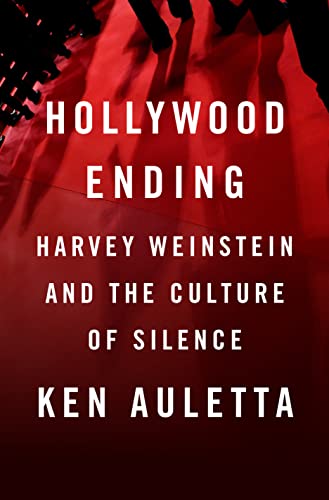 By KEN AULETTA (Penguin; 2022)
By KEN AULETTA (Penguin; 2022)
The latest in a long line of nonfiction accounts of the crimes committed by Harvey Weinstein. It follows Jodi Kator & Megan Twohey’s SHE SAID and Ronan Farrow’s CATCH AND KILL, which centered on their authors’ attempts at evading the barrage of threats and obfuscation thrown up by Weinstein, who went to near-insane lengths to keep his sexual exploits secret. Ken Auletta, a longtime NEW YORKER contributor, also attempted to detail Weinstein’s shenanigans after penning a 2002 expose on the man that left out the truly ugly parts (due to the fact that none of Weinstein’s alleged victims would go on record).
With HOLLYWOOD ENDING Auletta finally gets to write the full expose he always intended.
With HOLLYWOOD ENDING Auletta finally gets to write the full expose he always intended. His account isn’t as exciting or dramatic as those of Kator, Twohey and Farrow, but it does contain something their books didn’t: a reasonably thorough biographical portrait of Harvey Weinstein that doesn’t quite succeed in revealing just how a scrappy New York boy grew up to become perhaps the most prolific serial rapist of all time (as Auletta acknowledges, no real explanation exists for that), but does provide a riveting and disturbing history that outdoes most novels in sordidness and outrage.
…does provide a riveting and disturbing history that outdoes most novels in sordidness and outrage.
Weinstein’s major issue, as Auletta concludes, is that he’s a sociopath—i.e. a person who lacks “a fully functional conscience,” resulting in behavior that’s “manipulative, exploitative, or even abusive towards other people.” That adequately describes Weinstein, a morbidly obese narcissist who as portrayed here is a creature of appetite; particularly revealing is a description of a dinner with the man, who is recalled devouring “a thick, oozing hamburger” and leaving his table mate “worried he would be sprayed with food” as “Ketchup dripped from his fingers onto his white linen shirt, creating what looked like bloodstains.”
Weinstein’s major issue, as Auletta concludes, is that he’s a sociopath—i.e. a person who lacks “a fully functional conscience,” resulting in behavior that’s “manipulative, exploitative, or even abusive towards other people.”
Weinstein’s entrepreneurial skills were first exhibited during his college years at SUNY Buffalo. It was then, in 1972, that he put together a Stephen Stills concert and cultivated the mannerisms for which he’d become known. As one former acquaintance noted, the youthful Weinstein was “cunning, brash, loud, and volatile, often screaming at those who worked with him.”
He dropped out of college in his junior year and began exhibiting movies in the mid-1970s, after a Queens theater Weinstein and his brother Bob had acquired for rock concerts was found to have a wobbly balcony. This necessitated a shift to movie exhibition, and a screening of Claude Lelouch’s AND NOW MY LOVE/Toute Une Vie (1974), which marked the inception of Harvey and Bob’s legendary independent film company Miramax (an amalgamation of the names of Harvey and Bob’s parents Miriam and Max).
His first known rape victim was Hope D’Amore, a young film buff who in 1978 was assaulted in a hotel room by Weinstein. As would become an unfortunate pattern, D’Amore declined to report the assault to police, consumed with shame (a crucial component of the “culture of silence” signified by the book’s title), and Weinstein moved on, expanding both his business and his sexual appetite. By the turn of the millennium he and Bob had propelled Miramax into a global powerhouse, with funding from Disney and the adulation of seemingly everyone in Hollywood.
Yet Harvey’s bad behavior continued to accumulate, with ever more sexual assaults, a physical altercation against his brother Bob that was carried out in public and a highly acrimonious break from Disney. The end came in the fall of 2017, when a revealing NEW YORK TIMES article about Weinstein’s crimes, followed a week later by an equally damning Ronan Farrow authored NEW YORKER profile, appeared, leading to Weinstein’s expulsion from Hollywood and eventual incarceration—in which state he’s set to remain for the rest of his life.
I say the author spends too much time recounting the details of Weinstein’s criminal trial (presumably because Auletta himself was present for it). That is, frankly, not what I wanted to read about. What I was hoping for was an explanation of how Weinstein managed to get away with his 100-plus assaults for over forty years, but that, it seems, is something that’s destined to remain mysterious. One thing, at least, is certain: the oft-repeated claim that “nobody in Hollywood knew” about his excesses is complete and utter nonsense.
